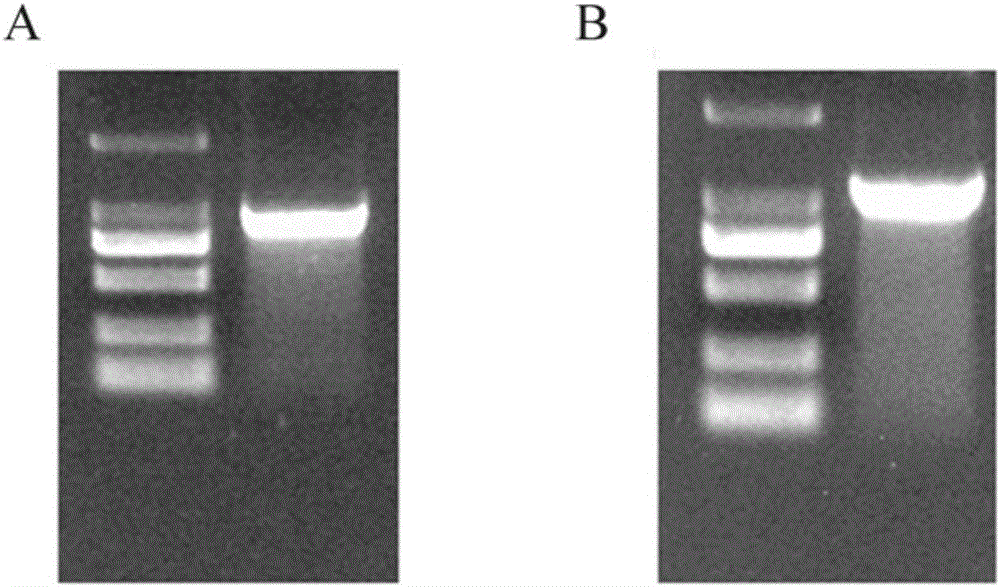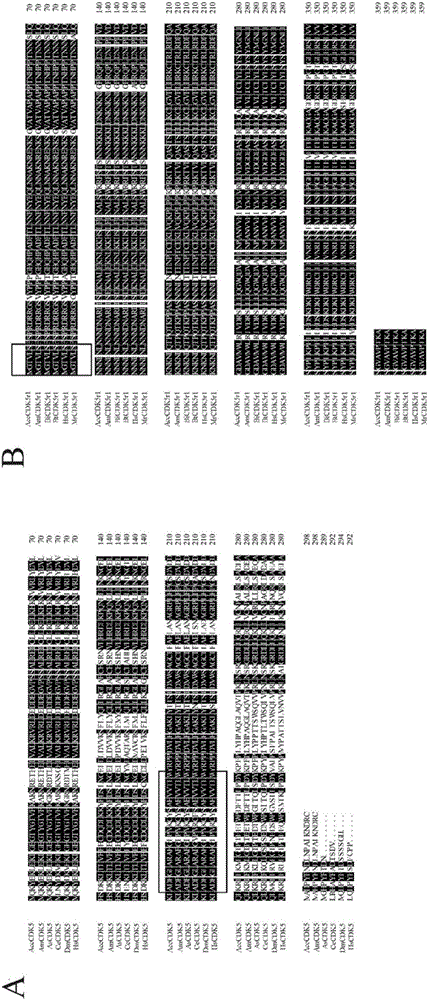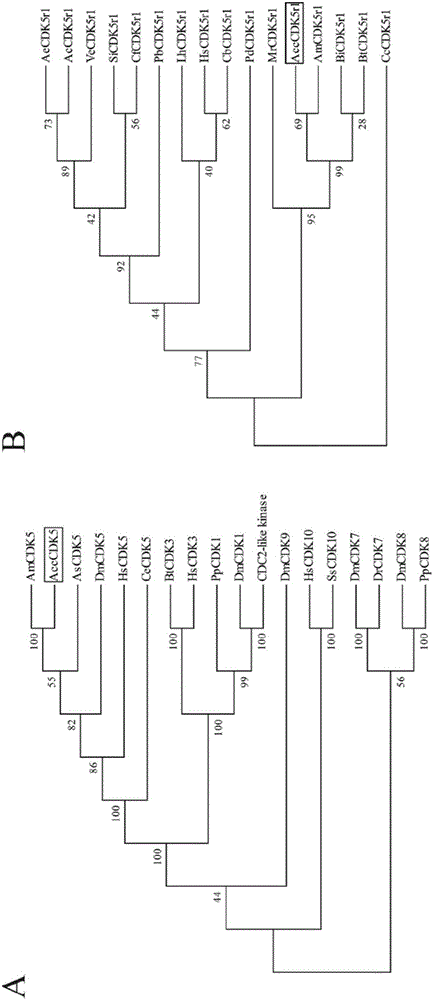AccCDK5 gene and AccCDK5r1 gene of Chinese honeybee and application of genes
A Chinese honeybee and gene technology, applied in the fields of application, genetic engineering, plant genetic improvement, etc., can solve the problems of population continuation threat and sudden decrease in the number of Chinese honeybee colonies.
- Summary
- Abstract
- Description
- Claims
- Application Information
AI Technical Summary
Problems solved by technology
Method used
Image
Examples
Embodiment 1
[0029] Example 1: Cloning of the AccCDK5 and AccCDK5r1 genes of Apis chinensis
[0030] With Apis cerana cDNA as template, forward primer (its nucleotide sequence is shown in SEQ.ID.NO.5) and reverse primer (its nucleotide sequence is shown in SEQ.ID.NO.6) to amplify To increase the AccCDK5 fragment, the reaction procedure is as follows: pre-denaturation at 94°C for 10 min → (94°C for 40 s, 52°C for 40 s) × 35 cycles → 72°C for 1 min → 72°C for 10 min.
[0031]Using the amino acid sequences of mammalian CDK5 activators p35 and p39 as a reference sequence, design AccCDK5r1 specific primers and use the cDNA of Apis chinensis as a template, and use the forward primer (its nucleotide sequence such as SEQ.ID.NO.7 Shown) and reverse primer (its nucleotide sequence is shown in SEQ.ID.NO.8) amplification AccCDK5r1 fragment, reaction procedure is as follows:
[0032] Pre-denaturation at 94°C for 10 minutes→(94°C for 40s, 55°C for 40s)×35cycles→72°C for 1min→72°C for 10min.
[0033] A...
Embodiment 2
[0035] Embodiment 2: Recombinant vector construction
[0036] After obtaining the nucleotide sequences of AccCDK5 and AccCDK5r1 genes, the recombinant vector and AccCDK5 prokaryotic expression vector required for the yeast two-hybrid experiment were first constructed:
[0037] First, the AccCDK5-BD recombinant vector was constructed: using the above-mentioned plasmid with correct sequencing as a template, using a forward primer, the nucleotide sequence of which is shown in SEQ.ID.NO.9 (5'- Catat GATGCAAAAATATGAGAAACTCGAG-3', the underlined part is the Nde I restriction site) and the reverse primer, the nucleotide sequence of which is shown in SEQ.ID.NO.10 (5'- GGATCC CTGACAACGATCGTTTTTAATGG-3′, the underlined part is the BamH I restriction site) to amplify the AccCDK5 fragment.
[0038] After the reaction, the PCR product was detected by 1.0% agarose gel electrophoresis, the target fragment was recovered and purified, connected with the vector pEASY-T1 simple, and sequenced...
Embodiment 3
[0041] Embodiment 3: yeast two-hybrid experiment
[0042] The Yeast Two-Hybrid System of the present invention adopts Matchmaker GoldYeast Two-Hybrid System, and this experiment is divided into three parts.
[0043] First, the AccCDK5-BD recombinant vector self-activation detection was carried out. The yeasts transformed into pGBKT7 empty vector and AccCDK5-BD recombinant vector were co-spread on SD / -Trp / -His solid medium and SD / -Trp / -Ade solid medium, and the results showed that neither of them grew, proving that AccCDK5 -BD recombinant vector has no self-activation phenomenon (such as Figure 4 shown in A).
[0044] Then AccCDK5-BD recombinant vector toxicity test was carried out. The yeast competent cells transferred into pGBKT7 empty vector and AccCDK5-BD recombinant vector were co-coated on SD / -Trp solid medium, and the results showed that the growth of the two was the same, which proved that the AccCDK5-BD recombinant vector was non-toxic (such as Figure 4 shown in ...
PUM
 Login to View More
Login to View More Abstract
Description
Claims
Application Information
 Login to View More
Login to View More - R&D
- Intellectual Property
- Life Sciences
- Materials
- Tech Scout
- Unparalleled Data Quality
- Higher Quality Content
- 60% Fewer Hallucinations
Browse by: Latest US Patents, China's latest patents, Technical Efficacy Thesaurus, Application Domain, Technology Topic, Popular Technical Reports.
© 2025 PatSnap. All rights reserved.Legal|Privacy policy|Modern Slavery Act Transparency Statement|Sitemap|About US| Contact US: help@patsnap.com



